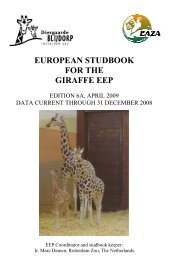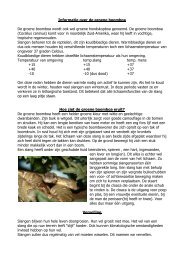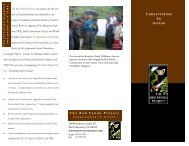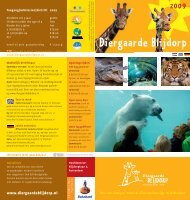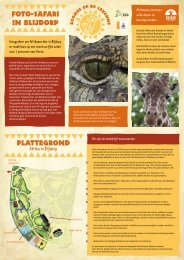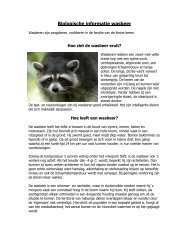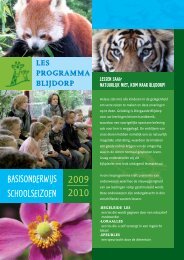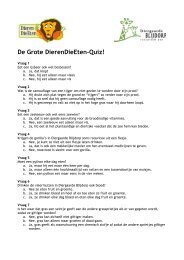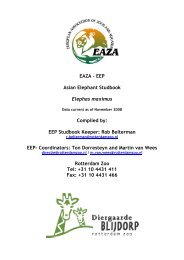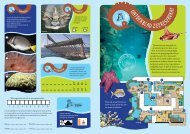Create successful ePaper yourself
Turn your PDF publications into a flip-book with our unique Google optimized e-Paper software.
EUROPEAN STUDBOOK CROWNED PIGEONS<br />
" an array of populations which are actually or potentially interbreeding, and which are<br />
reproductively isolated from other such arrays under natural conditions (Mayr, 1942)."<br />
In other words, a species is a group of organisms that interbreed and produce fertile offspring only<br />
with one another. Mayr's definition has enjoyed the broadest popularity of any definition offered<br />
for species, but there are both practical and conceptual difficulties with it's application during the<br />
course of biological classification.<br />
The three species of crowned pigeons are, in contradiction to the definition of a species,<br />
hybridizing. Both in the wild and in captivity, hybrids can be found. McMorris (1976) expects that<br />
the Goura scheepmakeri is a result of hybridization between Goura victoria and Goura cristata.<br />
These species both occur at the Siriwo River in the northeast of New Guinea and they are<br />
hybridizing there too. The northern border of the range of Goura scheepmakeri is not far from this<br />
point, so it might be possible that the hybrids have moved and settled themselves in the southern<br />
part of New Guinea. This seems very plausible, also because of the colours of the different species.<br />
In addition, comparing studies of the behaviour of the three species did not show any differences in<br />
the behaviour of the species (Lommers, 1982; Van Rijn 1995). For this reason, it is probably better<br />
to call the three species geographical races. But, geographical races may in time come to differ so<br />
much from their parent stock that they evolve into new species (Goodwin, 1983).<br />
Probably in the past the three species of crowned pigeons were geographical races, derived<br />
from one species. They could have disappeared from large areas of its range through alteration of<br />
the habitat, leaving isolated populations separated by areas of country no longer suitable for it.<br />
When they came together again they have differed so much from their parent own stock, that they<br />
have been evolved into a new species (Beehler, 1981).<br />
The island of New Guinea used to be part of Australia (Pratt,1981) and at the edge of two plates,<br />
New Guinea is tectonically active, with a considerable history of mountain-uplift, volcanic activity<br />
and earthquakes. Today this is a still continuing process (Beehler et al., 1986). In New Guinea<br />
several different geographical sub regions can be distinguished, each with some characteristic flora<br />
and fauna. Lowland rainforest occurs along the entire coast, being broken in a few places by<br />
anthropogenic grassland or eucalypti savannah. However, at the moment large areas of tropical<br />
rainforest occur only in three regions:<br />
• The vast Fly Platform south of the Central Ranges, extending from about Etna Bay at the<br />
neck of the Vogelkop to Hall Sound on the SE peninsula, home of the Scheepmaker’s<br />
crowned pigeons<br />
• In the west, the Vogelkop peninsula, where the common crowned pigeons occurs, and<br />
• In the north, the watershed of the Mamberambo River and its tributaries and adjacent<br />
coastal plains, and the Sepik and Ramu basins. In this area the Vicoria’s crowned pigeons<br />
occur.<br />
Most of the islands, where crowned pigeons occur, are co-called ‘land-bridge islands’. Land-bridge<br />
islands were in the past connected to the mainland (New Guinea), but since the sea level has risen,<br />
they became isolated (Diamond, 1973). This development has taken place only recently.<br />
Conclusion<br />
Sometimes it is easy to determine species and subspecies, but because of the continuous evolution<br />
of the earth, there are always mixed forms. Without doubt, all forms of crowned pigeons derive<br />
from one species and they might have become separated by environmental and climatic changes.<br />
They differ already a lot in phenotype, and DNA-research proved that their genotype is also quite<br />
different.<br />
162



